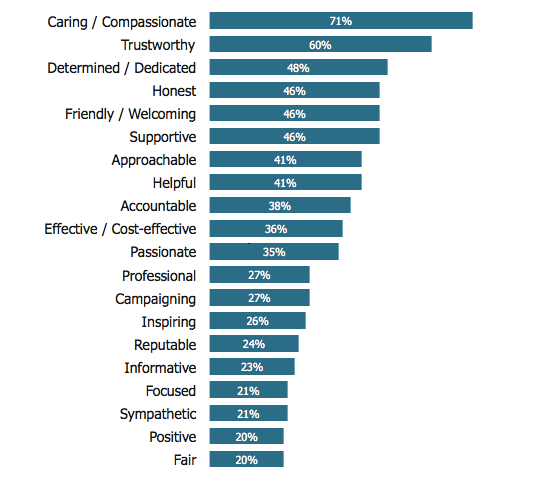Secil Muderrisoglu and Kate Cranston-Turner look at attributes of an ideal charity and talk about what it takes to be the best.
The growing mistrust of charities in the media and among politicians calls into question how charities would like to be seen by their supporters or the wider public. Whether or not we agree with the conclusions of recent newspaper headlines we all know how important it is for charities continue to maintain their reputations as honest and accountable, and how quickly negative stories can damage the sector as a whole.
At nfpSynergy we run a twice-yearly survey which looks in-depth at the public’s understanding of and affinity with different charity brands – our Brand Attributes survey. This includes a wide range of questions which look at people’s emotional responses to different charities, as well as how their relationship with a charity affects their understanding and reactions to it. One core question asked in every survey examines the key attributes people associate with individual charities and benchmark these against the public’s ideal charity. We know, and have repeatedly found, that it is unlikely that any charity will be able to match every element of the desired criteria. Having spent over a decade researching these attributes means we can also evaluate how the public’s image of the ideal charity has changed over time. This gives us a really useful insight into those aspects of the charity sector which the public are happy with, as well as those where charities are perceived to be falling behind.
Top 20 Ideal Charity Attributes
The results from our April/May 2015 survey can be found below.

From the data, we can see that the public’s ideal charity is one that is caring/compassionate (71%), trustworthy (60%), dedicated/determined (48%) and friendly/welcoming (46%). Other key attributes include being honest (46%), supportive (46%) and approachable (41%).
Indeed the top choice of attributes seems to fall largely into two camps - with the first being focused on the caring and amicable nature of a charity, and the second its trustworthiness. The least wanted attributes for an ideal charity are conservative (2%), cautious (2%), greedy/rich (1%), exclusive (1%) and boring (0%).It is interesting that being boring is considered the least attractive quality, falling behind other negative terms such as conservative and exclusive.
Of course associated charity’s desired image will vary greatly depending on their work and focus. A charity that focuses on providing care will have more chance of presenting itself as caring and compassionate and indeed approachable compared to a campaigning or research focused charity. Looking at the public’s ideal charity attributes across different sectors provides further illuminating results. When we ask the public about child welfare charities, we find that being seen to be accountable (46%) becomes even more important. For overseas aid and development charities, the public are less concerned that these charities are caring and compassionate but, when compared to all other sectors, effective/cost-effective attributes score the highest for the overseas aid sector.
The key words coming out of this research shouldn’t be overlooked. Analysing our data over a period of five years we see that ‘caring/compassionate’ has continued to rise, overtaking ‘trustworthy’ as the most important attribute for the ideal charity. Considering this trend was pre-Olive Cooke and the subsequent flurry of negative news articles we will be keeping a close watch on these two leading attributes for our autumn 2015 survey.
Our Brand Attributes survey reveals that the two most challenging terms for all charities seems to be “accountable” and “cost-effective”. These are the key areas where individual charities fall down. As the importance of accountability has grown in the public’s mind, mostly due to negative stories around the sector as a whole, individual charities need to do more to highlight how they are answerable for their actions. On the other hand, we know that the public is often sceptic regarding terms around cost effectiveness, accountability and anything relating to their donations being spent wisely. Also, accountability and effectiveness are not as clear in terms of their meaning as some other attributes are in the first instance.
Compared to last year, attributes which displayed the biggest surge are “supportive” , a 7% increase, followed by “helpful” and “caring/compassionate”, both of which increased by 6%, whilst “reputable”, “trustworthy” and “accountable” all fell by around 4%. This could be due to public spending cuts under the coalition government, which have put charities under increasing pressure in terms of providing support, care and help.
Our research into brand could help your organisation smarten up its appeal and ability to engage with the public. Brand Attributes will help you to:
- Establish what the public want from their ideal charity and how you compare
- Understand the way people perceive your brand and how this might affect the contact you have with your target audiences
- Identify and address any limitations or misconceptions of your brand and the work you do
- Learn how key audiences, supporters, volunteers and service users differ in their expectations and priorities
You can find out more about this survey by downloading a free briefing pack from the right hand side of this page or reaching us at ba@nfpsynergy.net
written by Secil Muderrisoglu and Kate Cranston-Turner

